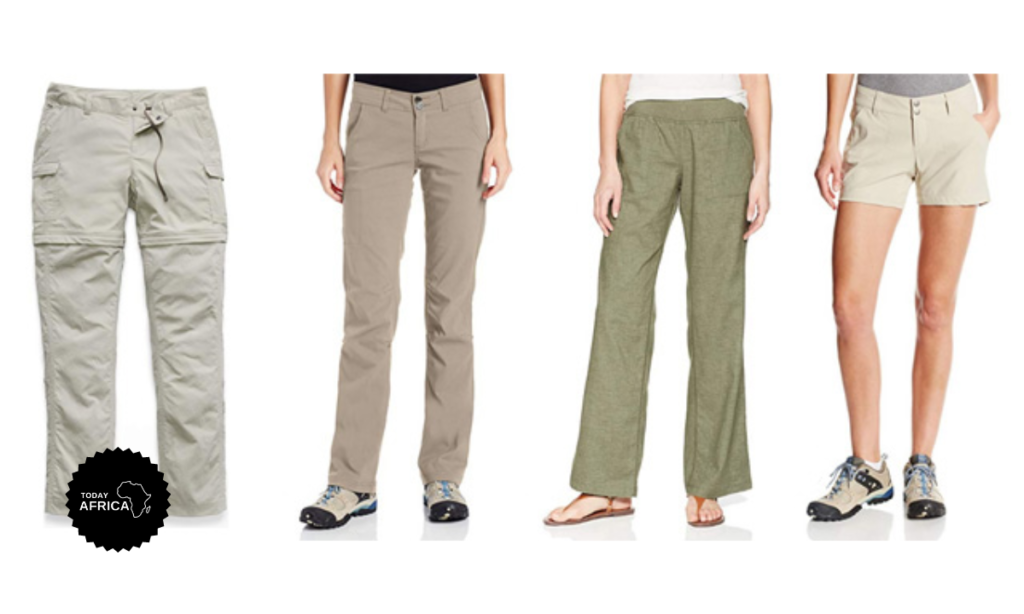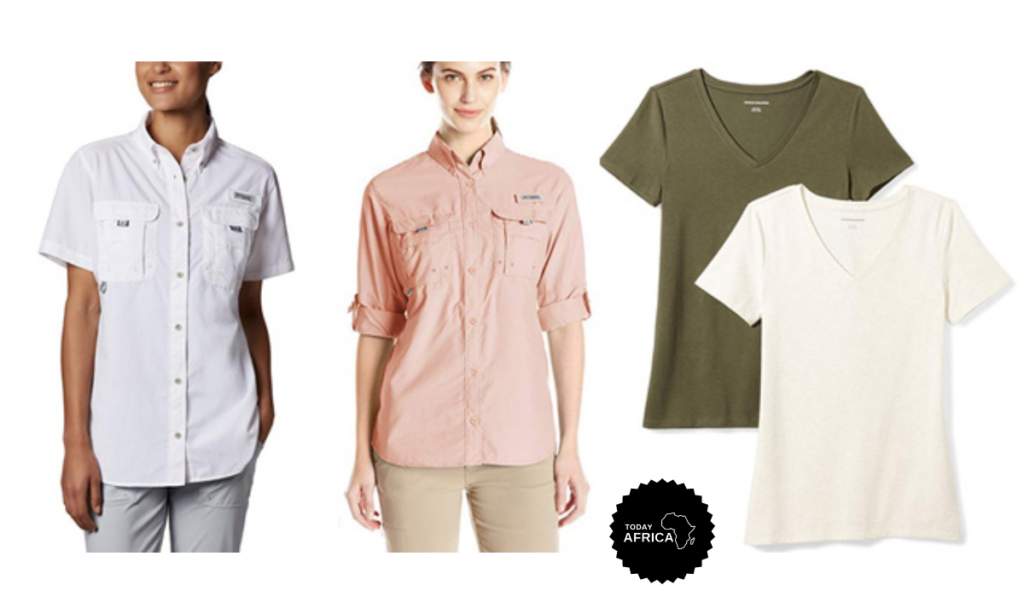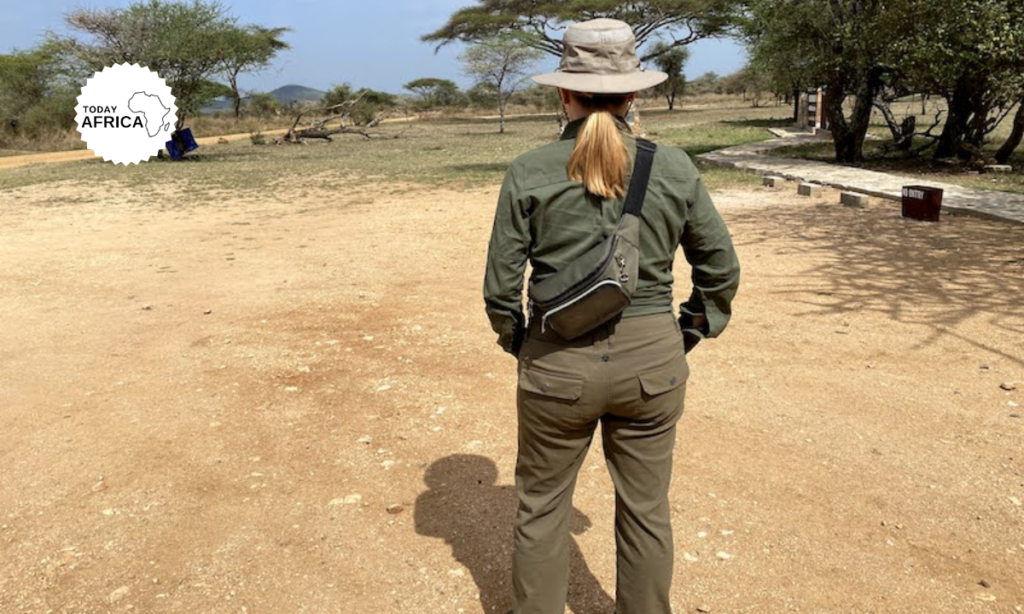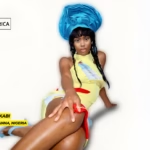The focus of your safari attire should be on comfortable safari clothing in neutral colors and light fabrics. If it’s not something you would feel comfortable wearing something on an overnight flight, it’s best to keep it out of your safari gear.
Safari clothes for Africa should be relaxed, so you can enjoy the experience to the fullest. The drive time on overland trips can vary anywhere from 6 to 12 hours each day. Making comfort key on those long-haul journeys — the distances in Africa are massive!
Expect your safari clothing to be covered in dust and keep in mind that you won’t have much time to do laundry. Your safari clothes should feature synthetic fabrics that are hard wearing, quick-dry, easy to wash, and won’t show dirt or dust.
What to Wear on Safari
When it comes to options for what to wear on an African safari, women’s travel brands tend to feature technical fabrics focusing primarily on khaki and olive colors. But unless you’re planning to live in the bush or are taking a Gorilla trekking trip to the jungle, it’s likely that this type of clothing isn’t necessary.
See Also: Kenya Safari Clothing For This Year
The majority of Africa safari tours will see you viewing animals within the confines of a vehicle, whether a giant overland truck or 4×4 car. This means that the khaki safari shirt or safari pants that you purchased will tragically go to waste.
Recommended women’s safari packing list
- 4 sleeveless or short-sleeve tops
- 2 long-sleeve tops
- 1 dress or skirt
- 4 pants
- 1 shorts
- 1 windbreaker jacket
- 1 fleece or warm jacket
- 1 swimsuit
- 3 bras (sports bras are recommended)
- 3 socks
- 7-10 underwear
- 1 jacket
- 1 scarf
- 1 sunglasses
Women’s Safari Packing List
Safari pants

- 3 pairs of light cotton pants or pants that convert to shorts, or 3 pairs of light cotton pants and 1-2 pairs of shorts
- 1 pair of long cotton pants suitable for walking in the bush
- 1 pair of jeans or other casual long pants for the evening
Shirts
- 3 short sleeve shirts
- 2 long sleeve shirts (styles with tabbed, rollable sleeves are most versatile)
- 3 cotton t-shirts

Outerwear
- 1 lightweight jacket or windbreaker
- 1 safari vest for camera equipment (optional).
- Raincoat (Optional)
Shoes and accessories
- 1 pair of lightweight hiking or walking shoes. We’re big fans of shoes like these Merrell sneakers and New Balance trail running shoes for how lightweight they are and how well they pack. In most cases, they can pull double duty as hiking/walking shoes, and casual shoes for the evening so you can save space in your luggage.
- 1 pair of comfortable shoes for the evening
- 1 pair of flip flops or sandals for use in your room, at the spa, or around the pool
- 10 pairs of socks
- 10 pairs of undergarments
- 1 wide brimmed hat, especially to wear in safari vehicles while driving in the parks, as the tops are left open for game viewing and photography
- 1 swimsuit
- 1 bandana for dust and/or cooling
- sunglasses with UV protection
Optional items you may want to pack
- small personal flashlight
- binoculars
- universal wall plug adapter kit
Don’t forget to pack any medications you are currently taking at your time of travel. You should also consider packing your preferred pain relievers, lip balm, sunscreen, antiseptic cream, personal toiletries, and insect repellent with 35% DEET. Most camps will have these items on offer, but if you have a preference and the room in your luggage, by all means take it with you.
The Dos and Don’ts of Women’s Safari Packing List
Packing for your African safari can seem overwhelming, so let’s finish off by going over our main dos and don’ts when it comes to getting together your safari gear and planning your safari attire!

What should you not wear on safari?
What you shouldn’t wear for an African safari depends highly on the actual trip type that you’re participating in. An overland trip that touches on a variety of countries is going to mean different must-haves from a short safari to Kruger Park that’s smack in the middle of a longer trip.
If your African safari trip is long, you’re going to want to focus on making comfortable, practical safari clothing a priority. But if you’re headed on a short three-day trip, you can definitely get by with wearing regular clothes.
But for both trips, Today Africa recommend that you do not wear a romper on a safari — three days, seven days or otherwise. We know that we’ve mentioned this before, but it’s such an important note that we want to talk about it in a little more detail!
When you’re on an overland safari trip. It’s common place to simply pull over on the side of the road to go to the bathroom — in public — as there really aren’t bathrooms along the way. The reason why we stress that you shouldn’t wear rompers. Simple, going to bathroom in a romper means taking all of your clothes off to go to the bathroom.
While you might be able to find a somewhat “discreet” spot in the pushes to pop a squat. You’ll still be pulling off your entire romper in public. And it’s much harder to attempt to conceal the top and bottom half of your body at the same time. It’s much easier to focus on covering your backside.
What colors should you wear on safari?
As exciting as it is to experience nature in its rawest form, you don’t have to immerse yourself to the extent that your safari clothing completely blends in with the foliage and desert itself. We can leave that for the Hollywood movies!
With that in mind, the best colors for safari clothes include:
- Khaki
- Olive green
- Tan
- Brown
- Clay
- Grey
A tip for picking the best color for your safari clothing is to go with colors that are inspired by nature. Measure your clothes with the image above, if they’re in the same tone, intensity and relatively the same color they’re good to go. You’re looking to blend in, but you don’t have to look like Crocodile Dundee or wear full tactical gear!
What color should you not wear on safari?
If you’ve done your safari clothing due diligence, chances are you’ve come across something that tells you not to wear bright colors. It seems like a strange request, but it’s recommended that you choose neutral colors because you don’t want the animals to see you — if they do they might be scared off!
See Also: What to Pack for Kenya Safari This Year
Stick to neutral colors but avoid white because your safari clothes are bound to get very dirty, especially if you’re camping, and white will show it all!
Can you wear black on safari?
Wearing black on safari is not recommended. Black clothing attracts mosquitoes, and you’ll want to avoid that as much as possible to keep your trip its most enjoyable!
If you do end up bringing some black pieces, keep them to a minimum and opt for lightweight fabrics wherever possible!
References:







![15 Best Beaches in Morocco to See This Year [& Essential Packing List]](https://todayafrica.co/wp-content/uploads/2023/12/Blue-Simple-Dad-Appreciation-Facebook-Post-1200-×-720-px-6-9.png)








